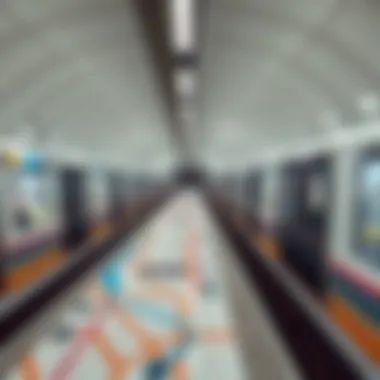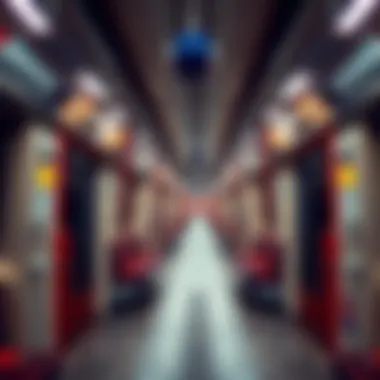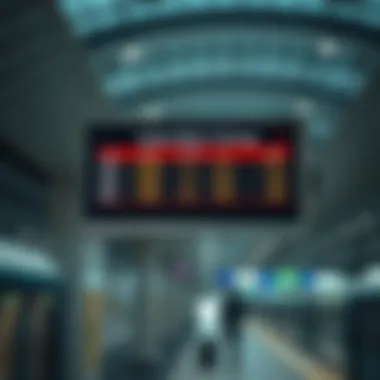Understanding Dubai Metro Timings and Operations


Intro
Navigating a city like Dubai can be a daunting task, especially for newcomers. With its sprawl and modern architectural wonders, the pulse of the city often flows through its public transport system, particularly the metro. Understanding when and how to use this vital mode of transportation can significantly enhance one’s experience in the city.
The metro system operates in a manner designed to accommodate a diverse range of commuters, whether they are residents rushing to work or tourists eager to explore. With a well-structured timetable and clear operational hours, the metro offers a reliable option for traversing Dubai’s many attractions and business districts. This guide dives into the comings and goings of the metro, shedding light on the schedules, influences on peak times, and how these factors can make or break your travel plans.
By paying attention to the timings and operations discussed here, readers can optimize their daily commutes or sightseeing adventures, ensuring that they make the most of their time in one of the world’s most dynamic cities.
Overview of Dubai Metro
The Dubai Metro stands as a vital pillar in the city’s rapidly evolving transportation landscape. For residents and visitors alike, understanding this metro system's operational framework is essential. With extensive coverage across the metropolis, the Metro not only eases the daily commute but also represents a significant leap in the city's commitment to sustainable public transport.
A key benefit of having a well-structured metro system is its ability to reduce traffic congestion. Given that Dubai is known for its luxurious lifestyle, the influx of expatriates and tourists can often lead to overcrowded roads. The Metro helps alleviate this pressure, ensuring that anyone can traverse the city without undue delay. Additionally, it serves as an environmentally friendly alternative to traditional road transportation, crucial in a world increasingly focused on sustainability.
In this article, we will further dissect the nuances of the metro operations, identifying several factors influencing its timings such as peak hours, maintenance schedules, and special events. By shedding light on these aspects, we aim to empower readers to better plan their journeys, making the most of what the Dubai Metro has to offer.
Intro to Dubai Metro System
Dubai's Metro system is an impressive feat of engineering and urban planning. Launched in 2009, it has quickly transformed into one of the most advanced urban rail systems in the world. Characterized by its driverless technology, the metro runs with remarkable efficiency, providing frequent services across its two main lines: the Red Line and the Green Line.
The design of the Dubai Metro also takes into account the city's cultural ethos and architectural identity. Stations are not merely functional; they are dazzling structures that often embody the futuristic vision of Dubai itself. For instance, the Burj Khalifa/Dubai Mall station offers seamless access to one of the world’s tallest skyscrapers, emphasizing the integration of transport and commerce.
In addition, the metro system encompasses 53 kilometers and connects over 45 stations, serving both residential areas and essential landmarks. As a result, the Metro becomes a lifeline for many commuting daily for work, school, or leisure activities.
Significance of Public Transportation in Dubai
Public transportation in Dubai plays an integral role in fostering economic growth and urban development. As the emirate witnesses rapid expansion, effective public transit ensures that the influx of people is managed efficiently. The Metro system facilitates easier movement, effectively linking workplaces with residential areas, which can greatly improve overall quality of life.
Moreover, investments in public transport reflect a broader strategy to decrease reliance on personal vehicles. By promoting the use of the metro, Dubai encourages a shift in mindset among its residents and visitors, prioritizing sustainability and reducing carbon emissions.
In addition to environmental benefits, the presence of a robust metro system can significantly enhance property values in surrounding areas. Homebuyers and investors increasingly recognize the connectivity offered by the metro, making properties near stations more attractive.
Thus, understanding the significance of public transportation extends beyond mere convenience; it encompasses economic viability, quality of life, and sustainable urban development.
Operating Hours of Dubai Metro
Understanding the operating hours of Dubai Metro is essential for both daily commuters and visitors exploring the city. Knowing when the metro runs helps individuals plan their journey more effectively, minimizing wait times and avoiding missed schedules. The metro system is one of the premier public transportation options in Dubai, connecting various neighborhoods and attractions. Therefore, the hours of operation directly impact both convenience and accessibility for users.
Standard Opening Hours
Typically, the Dubai Metro operates from 5:00 AM to midnight from Saturday to Thursday. This schedule is quite advantageous for early risers needing to commute to work or for those embarking on early morning adventures across the city. On Fridays, which are a special day of rest in the UAE, the metro opens later, beginning its service at 10:00 AM and running until midnight. This change reflects the cultural significance of Friday, allowing people to observe traditions while still benefiting from public transport.
Weekend vs Weekday Schedule


The difference in weekend and weekday schedules is quite noticeable. On weekdays, the frequency of trains increases during peak hours, approximately between 7:00 AM and 9:00 AM in the morning and 5:00 PM to 7:00 PM in the evening. During these intervals, commuters can expect a train every 2 to 5 minutes. The weekends, however, witness a slower pace with trains arriving every 7 to 10 minutes. This adjustment allows the metro system to accommodate fluctuating passenger volumes while maintaining efficiency.
Seasonal Variations in Operating Hours
Another significant aspect is the seasonal variations of operating hours. During major holidays or events, the metro often adjusts its timings. For instance, during Ramadan, the hours can change considerably to better serve those observing the fasting month. Trains may run later into the night to coincide with the Iftar meal, offering the community a convenient travel option post-sunset. Additionally, during special events like the Dubai Shopping Festival or Expo, extended hours might be implemented to cater to the influx of visitors.
Each of these factors contributes to a complex but manageable framework of operation that helps everyone navigate the city smoothly. Keeping an eye on these schedules allows for smoother travel experiences and enhances overall satisfaction with Dubai's public transportation system.
Metro Lines and Stations
Understanding the metro lines and stations of Dubai is essential for travelers and residents alike. The metro system is not just a mode of transport; it's a lifeline of the city, connecting various neighborhoods and critical areas. With its growing number of lines, stations, and interconnections, the metro serves as a reliable method of commuting.
This article explores the significance, including the operational qualities conducive to easing daily commutes, the overall commuter experience, and benefits such as reduced congestion on roads, which improves the efficiency of urban living in Dubai.
Red Line Overview
The Red Line is a hallmark of the Dubai Metro system, stretching from Rashidiya to UAE Exchange. Boasting 29 stations, it opens up vital access points to significant malls, business districts, and attractions such as the Dubai Mall and Burj Khalifa.
One noteworhty feature of the Red Line is its accessibility. Each station is designed with user-friendliness in mind; wide entrances, elevators, and clear signage verify ease of navigation, particularly for those with disabilities or heavy luggage. Importantly, this line is also a great resource for investors looking to venture in real estate. Properties near this line have seen substantial growth, influenced by pedestrian traffic resulting from the metro’s convenience.
Green Line Overview
Running parallel with the Red Line, the Green Line significantly supplements the metro framework of the city. It stretches from Etisalat to World Trade Centre, covering 20 stations. The Green Line connects several important areas, as it serves local communities and major points like the Dubai International Financial Centre.
Many stations on this line provide direct access to the bustling markets and cultural hubs of Dubai, attracting tourists as well as residents. Not to forget, this line offers an economical opportunity for businesses, as their proximity to a metro station can enhance visibility and customer inflow immensely.
Interlinking Stations and Transfers
The interlinking stations between the Red and Green Lines represent a crucial aspect of the metro system. These strategic transfer points, like the Union and BurJuman stations, allow for seamless transitions between lines, facilitating a smoother travel experience for passengers.
"Having access to interconnections can drastically reduce travel time and improve overall journey satisfaction."
These stations not only foster a more integrated transport system but offer additional advantages for surrounding properties. Proximity to these transfer points is appealing for both investors and homebuyers, significantly increasing property values.
In summary, the infrastructure of the metro lines and stations is integral to understanding how Dubai operates as a dynamic city. With ongoing expansions and improvements, it’s likely that many more facets will emerge, elevating the overall efficiency and accessibility of public transportation.
Factors Influencing Metro Timings
Understanding what affects the operational hours of the Dubai Metro is key for anyone considering commutation in this bustling metropolis. Factors influencing metro timings not only improve the efficiency of the transport network but also cater to the needs of the riders, allowing them to make informed travel decisions based on real-time conditions. This section will delve into three main areas: passenger traffic patterns, impactful events, and maintenance schedules, each contributing significantly to how the system runs day in and day out.
Passenger Traffic Patterns
One cannot overlook the rhythms of daily life when discussing metro timings. Passenger traffic patterns are a pivotal element that dictates when and how often the metro runs. In Dubai, patterns vary throughout the week and across different times of the day. For instance, rush hour typically sees an influx of commuters traveling to and from work.


- Morning Peak (7 AM - 9 AM): During this period, you’ll find trains packed tighter than sardines in a can, as people from all walks of life hustle to their jobs.
- Midday Lulls: After the morning rush subsides, the metro experiences a significant decline in ridership. Therefore, operational frequency can be adjusted accordingly.
- Evening Rush (5 PM - 7 PM): Much like the morning, the evening hours bring another wave of commute, which requires trains to operate at full capacity.
Monitoring these patterns allows the metro operations team to fine-tune the service frequency, ensuring that trains are not only on time but also equipped to handle the waves of people.
Events Impacting Operations
Events—whether planned or spontaneous—also play a crucial role in dictating the metro’s operational timings. Major happenings like concerts, sports matches, or festivals in Dubai significantly affect commuter flow, resulting in adjustments to the metro schedule. For example, on days when events are scheduled at venues such as the Dubai World Trade Centre or the Dubai Mall, additional trains are often deployed to accommodate the influx of attendees.
Some pivotal points to consider include:
- Large Gatherings: Special events will likely prompt extended operational hours, ensuring that people can get to and from their destinations with ease.
- National Holidays: On public holidays, the metro typically sees altered timings to align with the city’s festive spirit, accommodating a surge of leisure travelers.
- Weather Events: Rare but impactful moments, like heavy rains, can also affect schedules, as safety protocols come into play.
The ability to adapt to different events is crucial for maintaining a smooth commuter experience, akin to a conductor orchestrating a symphony.
Maintenance Schedules and Their Effects
Just like any transport system, the Dubai Metro requires regular maintenance to ensure safety and reliability. Maintenance schedules can directly impact operational timings and, in turn, passenger experiences.
- Regular Maintenance: These are typically scheduled during off-peak hours to minimize disruption. Even so, there can be instances where it affects early morning or late-night service.
- Unscheduled Repairs: From time to time, unforeseen issues can arise, resulting in sudden service interruptions. While this can be a nuisance, the team acts swiftly to mitigate inconvenience, employing signage and notifications to guide commuters.
- Upgrades: Modernization efforts often require temporary service changes, but they ultimately lead to a more efficient and comfortable metro experience.
Long story short, effective management of maintenance schedules is vital for ensuring long-term reliability and safety, directly influencing the overall timeliness of the metro.•
Navigating the nuances of metro timings in Dubai empowers riders, turning potential hurdles into seamless moves across the city’s dynamic landscape.
For additional details about the operational dynamics of public transportation, visit Dubai Metro's official site or explore studies on urban transit systems on Britannica.
Tips for Utilizing Dubai Metro Effectively
When navigating the intricate landscape of public transport in a bustling metropolis like Dubai, understanding the nuances of the metro system can significantly enhance your commuting experience. This section explores practical advice for planning your journeys and understanding the fare structure, both integral to optimizing your time and resources while utilizing the metro. It serves as a lifeline for residents and visitors alike, ensuring a seamless and cost-effective transit experience across the city.
Planning Your Journey
Planning is essential when utilizing the Dubai Metro effectively. Here are several pointers to consider:
- Know Your Route: Before embarking on your journey, familiarize yourself with the metro map and identify the stations closest to your origin and destination. The Metro's Red and Green lines cover extensive parts of the city. Searching, for example, "Dubai Metro route map" online can provide instant visual guidance.
- Time Your Departures: Traffic patterns can vary quite a bit based on the time of day. If you're travelling during peak hours—typically from 7:30 AM to 9:30 AM and 5 PM to 7 PM—you might find yourself packed like sardines. Understanding when these rush hours occur is crucial to avoid unnecessary stress.
- Leverage the Metro App: The RTA app is quite the handy tool, providing real-time updates on train schedules, platform information, and service notifications. It’s worth downloading to ensure you're always in the know.
- Transfer Points: Not all metro lines run directly to your destination. Understanding where to make transfers can save you time and hassle. For instance, the Union Station and BurJuman Station are key interchanges that allow for smooth transitions between the Red and Green lines.
"A well-planned journey can save you both time and money, making your metro experience in Dubai much more enjoyable."
Understanding Metro Fare Structure
Grasping the fare structure is vital for making informed choices about your travel budget. Dubai Metro uses a Distance-Based Fare System designed to optimize usage. Here’s what you need to keep in mind:
- Nol Card: To hop on the metro, you will need a Nol Card. You can get this card at stations or select retail outlets. It's available in various forms—red for tourists and blue for frequent riders. Make sure to choose the one that aligns with your travel patterns.
- Fares According to Zones: The fare is determined by the number of zones you travel through. Dubai is divided into several fare zones, and the cost increases based on this. For example, a trip across one zone will cost less than traversing three zones.
- Daily Cap: On days when you're making multiple trips, you’ll be glad to know there’s a daily cap on charges. This means once you hit a specified amount, any subsequent journeys in that day are free, offering significant savings for frequent riders.
- Special Offers: Occasionally, the RTA holds promotions for frequent users or discounts for certain age groups, like seniors and students. Keeping vigilant for such offers can help you stretch your dirhams further.


Navigating the fare system may seem daunting at first, but with a bit of research and planning, it can be entirely manageable. Understanding these key components ensures your journeys are both efficient and economical.
Public Perception and Experiences
Understanding public perception and experiences relating to the Dubai Metro system is crucial for various stakeholders, including city planners, transport authorities, and even potential investors. The metro serves as a lifeline for many, a convenient transport option that connects the bustling economy of the city with its populace. Evaluating how users perceive timing and operational efficiency can shine a spotlight on both strengths and areas for improvement within the system.
Such insights benefit everyone when navigating or considering utilizing this asset. When a user consistently finds the metro reliable, it fosters a sense of trust, potentially increasing ridership. On the flip side, negative experiences around timing, crowded trains, or delays can lead to dissatisfaction and skew usage patterns. The narratives formed around these experiences often dictate public sentiment towards the entire system, influencing policy decisions.
User Feedback on Timing and Convenience
User feedback is the pulse of public transport systems. In the case of the Dubai Metro, numerous riders express their feelings on various platforms, from social media to dedicated public forums. Common themes emerge from this feedback regarding timing and convenience.
- Punctuality: Many travelers emphasize the importance of the metro running according to its schedule. Complaints often arise when trains face delays, particularly during peak hours. A punctual metro boosts user satisfaction and trust.
- Crowding: Experiences of overcrowded trains during rush hours surface frequently. Users often mention that waiting for the next train is a better option than squeezing into a packed carriage, especially if they're in a hurry.
- Accessibility: Feedback also highlights the need for more accessible routes during non-peak hours. Not all users are aware that certain lines don’t run as frequently during the night, which can lead to unexpected delays.
This user-generated feedback provides valuable points for performance assessment and potential enhancements. It guides decisions about adjustments in schedules, monitoring peak traffic times, and ensuring an intuitive travel experience.
Comparative Analysis with Other Cities
When we take a broader look, comparing the Dubai Metro system to other urban transport networks paints a clearer picture of where it stands. Cities like Tokyo, London, and New York offer distinct contrasts that can be enlightening.
- Tokyo: The Tokyo Metro operates on a stringent schedule, and trains arrive every few minutes even during off-peak hours, setting a high bar for convenience. Although they face similar overcrowding issues, users are usually forgiving due to the precise timing.
- London: The London Underground’s peak hour operations are noted for their reliability, but users often face delays due to signal failures. Timeliness is a major factor for London travelers, paralleling issues perceived in Dubai.
- New York: The MTA in New York has been critiqued for erratic service, especially during weekends, leading to a backlash against its reliability. In contrast, the Dubai Metro's consistent operational hours show a commitment to higher service standards.
By understanding these comparisons, Dubai can leverage proven models from other metropolitan areas to enhance its user experience. Actively engaging with user feedback, coupled with insights gained from studying other public transport systems, can lead the Dubai Metro toward evolution and refinement to meet the growing demands of its users.
"Public transport is not just about getting from point A to point B; it’s about creating a seamless experience that fits into people's lives."
This comparative insight can be pivotal for investors and future projects within the metro system, signaling towards innovation in infrastructure and service delivery. As the city continues to grow, aligning these factors with user expectations will be key to maintaining the metro system's reputation as a convenient and efficient method of transportation in Dubai.
Future of Dubai Metro Operations
The horizon of Dubai Metro operations is rich with promise and advancement, presenting significant implications for both commuters and investors. As the city continues to expand and adapt, the metro system's anticipated developments are vital to understanding its future utility and efficiency. This section focuses on the essential elements influencing the metro's operations, along with the benefits that these changes will provide. Recognizing these elements is key for homebuyers, investors, and real estate agents who wish to understand the growing connectivity of the city and its impact on property values.
Upcoming Developments and Expansions
Dubai's strategy for its Metro system involves a slew of upcoming expansions. The plans to extend both the Red and Green Lines are particularly noteworthy. While the Red Line currently covers crucial business districts and residential areas, its expansion aims to reach farther into the new urban developments such as the Dubai South district.
Similarly, the Green Line will see enhancements to connect more neighborhoods, making public transportation more accessible. Here are vital points on future expansions:
- Increased Coverage: More stations translate to easier access for commuters, particularly in newly developed regions.
- Integration with Other Transport Modes: New podiums will allow seamless transfers to the tram system and possibly future monorail systems. This integration encourages the use of public transport over personal vehicles, benefiting traffic and air quality.
- Passenger Capacity Enhancement: By increasing the size and number of trains during peak hours, Dubai Metro will cater to the ever-growing population and visitor numbers. This could lessen the congestion experienced during busy travel times.
As these developments unfold, the operational hours may also adapt to new patterns, making it beneficial for both residents and tourists alike. The focus will be on accommodating the need for flexibility and providing practical transit options throughout the day.
Innovations in Public Transportation
Dubai’s commitment to innovation is evident through its metro operations, showcasing advancements designed to enhance user experience. Key innovations include:
- Smart Technology: The use of AI to analyze passenger flows and optimize train schedules can lead to a more responsive system, significantly improving efficiency. Passengers may also benefit from smartphone applications that offer real-time updates on train timings.
- Sustainability Initiatives: With climate consciousness on the rise, Dubai plans to implement energy-efficient trains and solar-powered stations. This reflects a commitment not just to public transit, but also to environmental stewardship—a factor increasingly valued by investors and homebuyers.
- Enhanced Safety Measures: As operations expand, so does the need for enhanced safety protocols. Introduction of advanced surveillance and monitoring systems will ensure not only safety for passengers but also inspire confidence in those considering property investments in proximity to metro lines.
"The future of public transport systems, like the Dubai Metro, lies in its ability to adapt to modernization while addressing the needs of its users."
As these innovations materialize, potential buyers and investors should keep an eye on how proximity to metro stations can impact property desirability and market prices. The evolving landscape solidifies the metro’s position as a pivotal asset in Dubai's urban framework.











